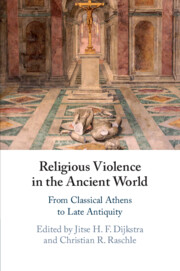Book contents
- Religious Violence in the Ancient World
- Religious Violence in the Ancient World
- Copyright page
- Contents
- Acknowledgements
- List of Contributors
- A Note on Abbreviations
- General Introduction
- Part I Methodology
- Part II Religious Violence in the Graeco-Roman World
- Chapter 3 Ancient Greek Binding Spells and (Political) Violence
- Chapter 4 The Expulsion of Isis Worshippers and Astrologers from Rome in the Late Republic and Early Empire
- Chapter 5 Religious Violence? Two Massacres on a Sabbath in 66 ce: Jerusalem and Caesarea
- Chapter 6 Religion, Violence and the Diasporic Experience: The Jewish Diaspora in Flavian Rome and Puteoli
- Chapter 7 Animal Sacrifice and the Roman Persecution of Christians (Second to Third Century)
- Chapter 8 The Great Persecution and Imperial Ideology: Patterns of Communication on Tetrarchic Coinage
- Chapter 9 The Violent Legacy of Constantine’s Militant Piety
- Part III Religious Violence in Late Antiquity
- Index of Sources
- General Index
Chapter 9 - The Violent Legacy of Constantine’s Militant Piety
from Part II - Religious Violence in the Graeco-Roman World
Published online by Cambridge University Press: 18 September 2020
- Religious Violence in the Ancient World
- Religious Violence in the Ancient World
- Copyright page
- Contents
- Acknowledgements
- List of Contributors
- A Note on Abbreviations
- General Introduction
- Part I Methodology
- Part II Religious Violence in the Graeco-Roman World
- Chapter 3 Ancient Greek Binding Spells and (Political) Violence
- Chapter 4 The Expulsion of Isis Worshippers and Astrologers from Rome in the Late Republic and Early Empire
- Chapter 5 Religious Violence? Two Massacres on a Sabbath in 66 ce: Jerusalem and Caesarea
- Chapter 6 Religion, Violence and the Diasporic Experience: The Jewish Diaspora in Flavian Rome and Puteoli
- Chapter 7 Animal Sacrifice and the Roman Persecution of Christians (Second to Third Century)
- Chapter 8 The Great Persecution and Imperial Ideology: Patterns of Communication on Tetrarchic Coinage
- Chapter 9 The Violent Legacy of Constantine’s Militant Piety
- Part III Religious Violence in Late Antiquity
- Index of Sources
- General Index
Summary
It should shock us – and it would have shocked a number of early fourth-century Christians – that the Emperor Constantine (306–37) continued a seventy-five-year long tradition of soldier-emperors’ militant piety from the time he took power,1 into the period of his conversion to Christianity, and up to the end of his reign. For the ease with which Constantine promoted the novel image of a Christian military commandant, I argue, we have Lactantius (fl. 299–315) to thank. In his Divine Institutes, this African professor of rhetoric set out the template for Constantine as the ideal Christian conqueror-emperor and violent avenger of evil. As Lactantius identified this ‘evil’ as the actions of polytheistic emperors who had persecuted Christians, his template envisions the emperor as an agent of religious violence in response to religious violence. However comprehensible Lactantius’ response, this image is wildly at odds with the previous conception of the Christian hero, that of the martyr, known for enduring, not promoting, violence. Taking inspiration from the circumstances of Constantine’s accession, Lactantius’ Divine Institutes sketched the outline of a Christian sovereign.
- Type
- Chapter
- Information
- Religious Violence in the Ancient WorldFrom Classical Athens to Late Antiquity, pp. 228 - 248Publisher: Cambridge University PressPrint publication year: 2020



